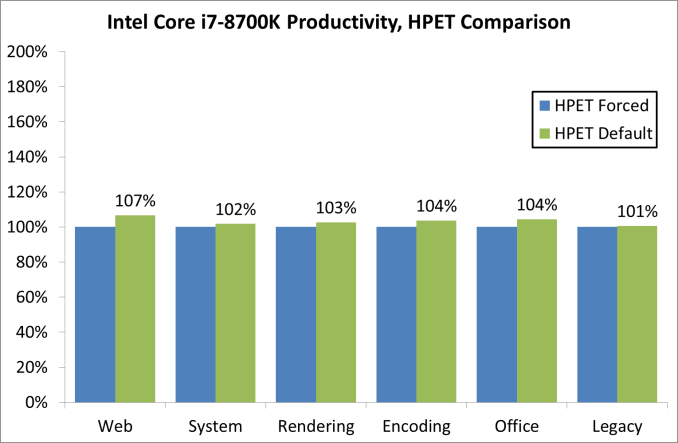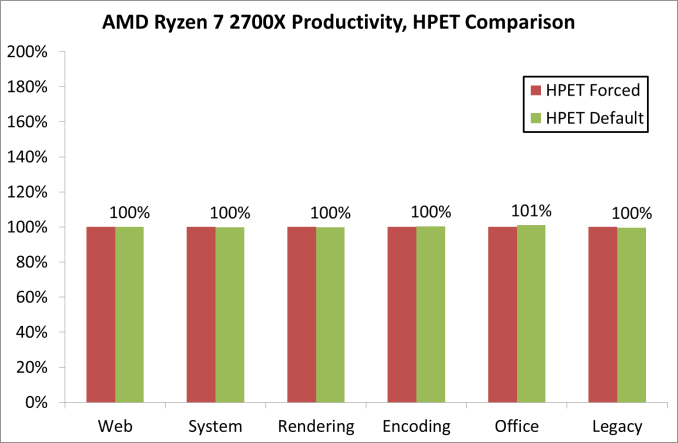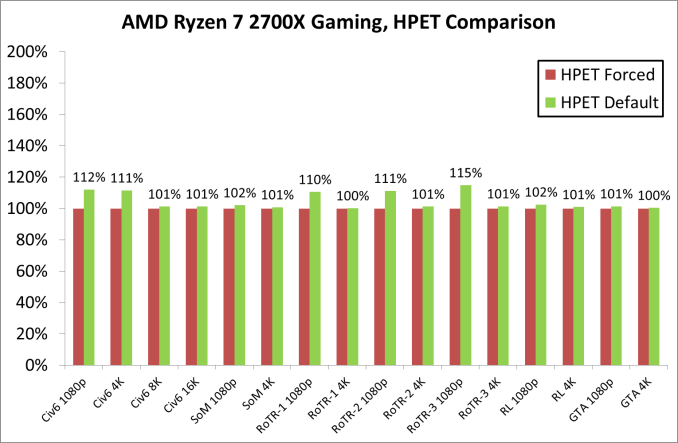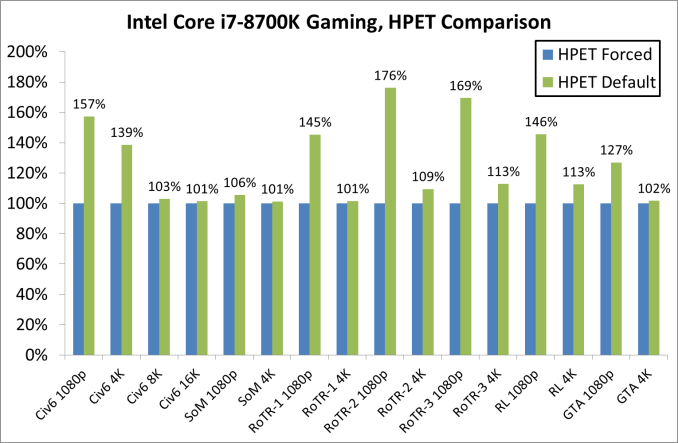A Timely Discovery: Examining Our AMD 2nd Gen Ryzen Results
by Ian Cutress & Ryan Smith on April 25, 2018 11:15 AM ESTForcing HPET On, Plus Spectre and Meltdown Patches
Based on my extreme overclocking roots back in the day, my automated benchmark scripts for the past year or so have forced HPET through the OS. Given that AMD’s guidance is now that it doesn’t matter for performance, and Intel hasn’t even mentioned the issue relating to a CPU review, having HPET enabled was the immediate way to ensure that every benchmark result was consistent, and would not be interfered with by clock drift on special motherboard manufacturer in-OS tweaks. This was a fundamental part of my overclocking roots – if I want to test a CPU, I want to make certainly sure that the motherboard is not causing any issues. It really gets up my nose when after a series of CPU testing, it turns out that the motherboard had an issue – keeping HPET on was designed to stop any timing issues should they arise.
From our results over that time, if HPET was having any effect, it was unnoticed: our results were broadly similar to others, and each of the products fell in line with where they were expected. Over the several review cycles we had, there were a couple of issues that cropped up that we couldn’t explain, such as our Skylake-X gaming numbers that were low, or the first batch of Ryzen gaming tests, where the data was thrown out for being obviously wrong however we never managed to narrow down the issue.
Enter our Ryzen 2000 series numbers in the review last week, and what had changed was the order of results. The way that forcing HPET was affecting results was seemingly adjusted when we bundle in the Spectre and Meltdown patches that also come with their own performance decrease on some systems. Pulling one set of results down further than expected started some alarm bells and needed closer examination.
HPET, by the way it is invoked, is programmed by a memory mapped IO window through the ACPI into the circuit found on the chipset. Accessing it is very much an IO command, and one of the types of commands that fall under the realm of those affected by the Spectre and Meltdown patches. This would imply that any software that required HPET access (or all timing software if HPET is forced) would have the performance reduced even further when these patches are applied, further compounding the issue.
It Affects AMD and Intel Differently: Productivity
So far we have done some quick initial re-testing on the two key processors in this debate, the Ryzen 7 2700X and Intel Core i7-8700K. These are the two most talked about processors at this time, due to the fact that they are closely matched in performance and price, with each one having benefits in certain areas over the other. For our new tests, we have enabled the Spectre/Meltdown patches on both systems – HPET is ‘on’ in the BIOS, but left as ‘default’ in the operating system.
For our productivity tests, on the Intel system, there was an overall +3.3% gain when un-forcing HPET in the OS:
The biggest gains here were in the web tests, a couple of the renderers, WinRAR (memory bound), and PCMark 10. Everything else was pretty much identical. Our compile tests gave us three very odd consecutive numbers, so we are looking at those results separately.
On the AMD system, the productivity tests difference was an overall +0.3% gain when un-forcing HPET in the OS:
This is a lower gain, with the biggest rise coming from PCMark10’s video conference test to the tune of +16%. The compile test results were identical, and a lot of tests were with 1-2%.
If Affects AMD and Intel Differently: Gaming
The bigger changes happen with the gaming results, which is the reason why we embarked on this audit to decipher our initial results. Games rely on timers to ensure data and pacing and tick rates are all sufficient for frames to be delivered in the correct manner – the balance here is between waiting on timers to make sure everything is correct, or merely processing the data and hoping it comes out in more or less the right order: having too fine a control might cause performance delays. In fact, this is what we observe.
With our GTX 1080 and AMD’s Ryzen 7 2700X, we saw minor gains across the board, however it was clear that 1080p was the main beneficiary over 4K. The 10%+ adjustments came in only Civilization 6 and Rise of the Tomb Raider.
Including the 99th percentile data, removing HPET gave an overall boost of around 4%, however the most gains were limited to specific titles at the smaller resolutions, which would be important for any user relying on fast frame rates at lower resolutions.
The Intel side of the equation is where it gets particularly messy. We rechecked these results several times, but the data was quite clear.
As with the AMD results, the biggest beneficiaries of disabling HPET were the 1080p tests. Civilization 6 and Rise of the Tomb Raider had substantial performance boosts (also in 4K testing), with Grand Theft Auto observing an additional +27%. By comparison, Shadow of Morder was ‘only’ +6%.
Given that the difference between the two sets of data is related to the timer, one could postulate that the more granular the timer, the more the effect it can have: on both of our systems, the QPC timer is set for 3.61 MHz as a baseline, but the HPET frequencies are quite different. The AMD system has a HPET timer at 14.32 MHz (~4x), while the Intel system has a HPET timer at 24.00 MHz (~6.6x). It is clear that the higher granularity of the Intel timer is causing substantially more pipeline delays – moving from a tick-to-tick delay of 277 nanoseconds to 70 nanoseconds to 41.7 nanoseconds is crossing the boundary from being slower than a CPU-to-DRAM access to almost encroaching on a CPU-to-L3 cache access, which could be one of the reasons for the results we are seeing, along with the nature of how the HPET timer works.
There is also another aspect to gaming that does not appear with standard CPU tests: depending on how the engine is programmed, some game developers like to keep track of a lot of the functions in flight in order to either adjust features on the fly, or for internal metrics. For anyone that has worked extensively on a debug mode and had to churn through the output, it is basically this. If a title had shipped with a number of those internal metrics still running in the background, this is exactly the sort of issue that having HPET enabled could stumble upon - if there is a timing mismatch (based on the way HPET works) and delays are introduced due to these mismatches, it could easily slow down the system and reduce the frame rate.














242 Comments
View All Comments
Timur Born - Friday, April 27, 2018 - link
It's noteworthy that HPET use at default Windows settings is a black box, aka Windows decides whether to use it or not unless software makes an effort to get more control over it. Windows decision to use one or the other time depends on hardware platform, Windows revisions (even small updates) and even the mixture of software you are currently running.This also means that the HPET "bug" reported here and on Overclocker.at can hit everyone without them even knowing when and why. Some people prefer to disable the HPET completely, albeit I am not a fan of this "solution". Instead I would very much expect Intel to get a hold of the situation and fix the issues their hardware is experiencing when HPET is used.
Again, the default Windows behavior is not to *not* use HPET, but only to make seldom use of it if applicable. Seldom/applicable use issues are still issues.
eva02langley - Friday, April 27, 2018 - link
You guys should really analyze the FPS with specific tools like slow motion camera for calculating the refresh rate. Something is fishy here...Also, how in hell is AMD not affected? Is it because Intel is reaching too much FPS in some games at 1080p?
Is this a software or hardware issue? Is it the same on Linux... if Linux is having HPET?
Jacobb20970 - Friday, April 27, 2018 - link
Going to see if, perhaps, HPET timings are even more granular on "server"-class systems. My Intel dual 2011 board (Sandy/Ivy Bridge) with dual Xeons has... exceptionally poor performance in certain applications relative to findings over at NATEX with a multitude of identical systems. I may have enabled HPET on accident with a monitoring application at some point.Although it's not likely a root cause of my performance issues, anything I can scrape out of the system would be nice.
Ninjawithagun - Friday, April 27, 2018 - link
I choose to not believe AnandTech's convenient flaw with regards to the Intel's default vs. forced HPET performance. I will wait for several other hardware reviewers to confirm or debunk these results before I would tell anyone to make a decision. Something smells fishy about this whole thing. Why is the Intel HPET now all the sudden an issue? Or a better question, is AnandTech now in Intel's pocket?eddman - Saturday, April 28, 2018 - link
"Why is the Intel HPET now all the sudden an issue?"... because other websites do not force HPET on with intel CPUs during benchmarks, meaning they never encountered this issue. Anandtech was forcing HPET to be used which is not the default state and caused problems.
LurkingSince97 - Friday, April 27, 2018 - link
I think it would be useful / important in future CPU reviews to include a couple tests that measure the HPET performance impact when forced on. People will want to know, and it provides an interesting side-story for new CPUs or updated platforms / OS.Also, I think it provides a public service, since if ordinary users run into this (perhaps by some third party software install forcing it on) they might go crazy trying to understand why their gaming performance tanked. A (small) page on this topic in each new CPU review will remind people that this is an important thing to consider if they are debugging issues on their own system!
ConstructionKing - Saturday, April 28, 2018 - link
Great PostConstructionKing - Saturday, April 28, 2018 - link
<a href="http://www.inframall.net/">Inframall</a... is a <a href="http://www.inframall.net/">construction service provider in Ernakulam</a> . They provides a better hassle free construction experience to the customers. Visit : <a href="http://www.inframall.net/">Inframall</a...ConstructionKing - Saturday, April 28, 2018 - link
Inframall is a construction service provider in Ernakulam. They provides a better hassle free construction experience to the customers. Visit : http://www.inframall.netConstructionKing - Saturday, April 28, 2018 - link
Get certified professionals for all the civil construction work right from foundation stage to the completion stage at a minimum cost . Click to find services : http://www.inframall.net/civil.php